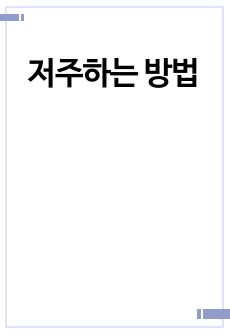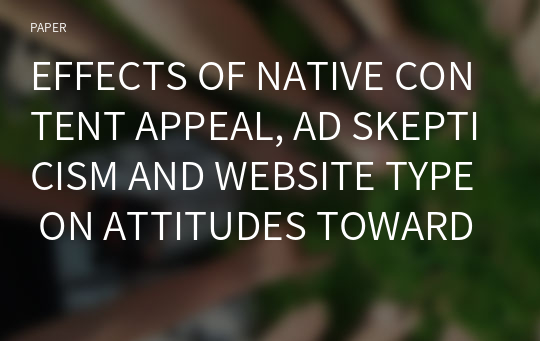EFFECTS OF NATIVE CONTENT APPEAL, AD SKEPTICISM AND WEBSITE TYPE ON ATTITUDES TOWARD THE AD, PEOPLE’S WEBSITE EVALUATION AND PERSUASION KNOWLEDGE
* 본 문서는 배포용으로 복사 및 편집이 불가합니다.
서지정보
ㆍ발행기관 : 글로벌지식마케팅경영학회(GFMC)
ㆍ수록지정보 : GFMC Session1
ㆍ저자명 : Ana Clara Meirelles Vitale, Sooyoung Cho
ㆍ저자명 : Ana Clara Meirelles Vitale, Sooyoung Cho
영어 초록
The purpose of this study is to find out how effective native content can be and how much 1) the web site type (news vs. entertainment vs. social networking site) and 2) the native content appeal (emotional vs. informational) will influence reader’s evaluations about a) the ad/website where the ad is placed and b) reader’s persuasion knowledge. The study also included an individual’s ad skepticism as one of the independent variables, arguing that the level of ad skepticism will influence the evaluations about the ad/website and individual’s persuasion knowledge. The result of the study can be helpful for advertisers to decide where and how to present native content. An online experiment, 3 (website type: news site/entertainment site/Facebook) X 2 (native content appeal: emotional/informational) X 2 (individual’s ad skepticism: high/low) was conducted to estimate the effects of independent variables on dependent variables, such as attitude towards the ad, website’s evaluation and individual’s persuasion knowledge.Introduction
One of the newest ways of online advertising is ‘native ad’ or ‘native content.’ This new form of advertising provides companies the opportunity to introduce their products or services in a more natural way via online. Native ads normally match the design of other contents presented in the website and it should be perceived naturally as the rest of the content there (for example, in an online news site, the ad should be presented as news). Since native ads fit into the design of the site and people are there looking for stories to read, they provide higher rates of engagement as well as brand perception. However, there is a possibility of people feeling ‘deceived’ after realizing the story they click to read is no other but advertising. Furthermore, in the case of news websites, there have been instances of disapproval regarding native content. One of the arguments against native content presented in news sites points out that it is not ethical to present ads in the format of news. On the other hand, paid content can be seen as a useful alternative for non-intrusive online advertising which can generate more views among the users.
Despite the increase of native content as a new form of advertising, academic study about native content (ads) is still difficult to find. The purpose of this study is to find out how effective native content can be and how much 1) the web site type (news vs. entertainment vs. social networking site) and 2) the native content appeal (emotional vs. informational) will influence reader’s evaluations about a) the ad/website where the ad is placed and b) reader’s persuasion knowledge.
The study also included an individual’s ad skepticism as one of the independent variables, arguing that the level of ad skepticism will influence the evaluations about the ad/website and individual’s persuasion knowledge. Native content appears naturally, functioning like the rest of the content in the website. This characteristic makes it difficult for some people to tell the difference between the editorial content and paid content. By including ad skepticism as an independent variable, this study will show how people with high/low levels of ad skepticism will deal with this type of advertising.
The result of the study can be helpful for advertisers to decide where and how to present native content. An online experiment, 3 (website type: news site/entertainment site/Facebook) X 2 (native content appeal: emotional/informational) X 2 (individual’s ad skepticism: high/low), was conducted to estimate the effects of independent variables on dependent variables, such as attitude towards the ad, website’s evaluation and individual’s persuasion knowledge.
Literature Review
Native Advertising and Evolution of Advertorials
Native advertising is a method marketers use to present content in an interesting and subtle way on different websites or social media in a way that is almost camouflaging with the other content presented there. According to a IPG Media Lab survey, native advertising presented 53% more exposure than banners and it showed better performance regarding purchase intention, brand closeness and share intention.
Native advertising’s origins can be found in what is defined as ‘advertorial’ (a combination of the words advertising and editorial). As we can find different arguments in native ads, we may also find discussions regarding similar topics related to advertorials. Cameron and Ju-Pak (2000)’s research supported that when stories are presented as editorial copy, they showed better credibility than those with a label of advertising. The ideas and main characteristics of advertorials appear today in native advertisements, bringing the advantages of advertorials to native ads. Marketers keep trying to make online advertising reliable and create effective sponsored content. However, as it was discussed with advertorials, when it appears difficult to tell the difference between news content and sponsored content, there is a possibility that the advertising is seen as deceptive (Pike, 2014). Since native content has become a popular online advertising format in reality, it is necessary to study it and the responses generated among the audience members of online news and different websites.
Persuasion Knowledge Model & Ad Skepticism
An individual’s ability to recognize and evaluate marketers’ persuasion goals and tactics is known as persuasion knowledge. Ad skepticism refers to a critical approach for consumers to evaluate and cope with advertising. Relating to the persuasion knowledge model and native content, one of the most important aspects for marketers is to determine the degree of persuasion knowledge that the target has in the different types of native content or the different website types where it is presented. This study will evaluate how an individual’s persuasion knowledge is affected after being exposed to native content. According to the persuasion knowledge model, we can assume that the more consumers know about the persuasion attempt of an agent, the lesser they are being persuaded. This study examined how the exposure to a new way of online advertising (native content) affects users’ persuasion knowledge.
In the meantime, consumers with a higher level of skepticism make it harder for advertisers to find the effective format of online advertising. Consumers with a high level of skepticism may also be more aware of advertising strategies which leads to less positive responses to ads that use subtle persuasive techniques (Obermiller & Spangenberg, 1998, 2000). Previous research has shown that ad skepticism varies depending on advertising formats: banner advertisements present higher levels of skepticism than sponsored content.
The present study differentiated persuasion knowledge from ad skepticism. Ad skepticism is regarded as a personal attribute. It is measured in order to find out how participants' level of ad skepticism (high/low) will influence the effects of native content. On the other hand, persuasion knowledge is seen as a way users will cope with advertising strategies. This research examined the effects different native advertising have on a reader’s persuasion knowledge.
Research Questions & Hypotheses
[RQ1]: Will the effect of native content on site evaluation be different depending on the website type, native content appeal and individual’s ad skepticism?
[RQ2]: Will content appeal and website type influence the effects of native content on site evaluation (before/after)?
[RQ3]: Will the effect of native content on persuasion knowledge be different depending on the website type, native content appeal and individual’s ad skepticism?
[RQ4]: Will the effect of native content on attitude towards the ad (affective/cognitive/behavioral attitude and advertising credibility) differ depending on website type, native content appeal and individual’s ad skepticism?
[H1]: Informational native content will show more positive cognitive attitude towards the ad than emotional content.
[H2]: Emotional native content will show more positive affective attitude towards the ad than informational content.
Research Method
An online experiment was conducted in May 2016 in Seoul, Korea. Using a convenient and snowball sample, a total of 359 adult participants aged 18 or older took part in the online experiment. Experiment stimuli were created based on existing brands with high-involvement products (LG G5 mobile phone and CITI credit card). Experimental stimuli were created by the researchers to resemble native content and native ads in news sites, entertainment sites, and Facebook. The format of the contents was adapted from native content published in different sites (news site: /entertainment site: Huffington Post Korea, ). Participants were randomly assigned to one of the 6 cells (3 website types X 2 appeals). First, ad skepticism was measured followed by website evaluation. After each stimulus was shown, attitude towards the native ad, site evaluation and persuasion knowledge were measured.
RESULTS AND DISCUSSION
Despite the growing popularity of native advertising in various online sites, little research has been performed regarding its effects and possible variables influencing the effects of native advertising. This study intended to contribute to find an effective way to create native content and a suitable place to place the native content. The study found significant interaction effects between content appeal and site evaluation (before/after). Also, significant interaction effects on persuasion knowledge were found between website type and content appeal. On the other hand, main effects of independent variables (native content appeal and ad skepticism) showed interesting results.
Results of RQ1 showed that a lower ad skepticism and informational content appeal presented more significant effects on site evaluation. In other words, participants with lower levels of ad skepticism were more likely to positively evaluate the site. Also, when comparing the types of appeal, informational native content turned out to be more effective on site evaluation than emotional appeal. However, the online experiment failed to detect a meaningful connection between website type and site evaluation.
Significant differences were found in terms of participants’ website evaluation before and after presenting experimental stimuli, native content (RQ2). Contrary to what was expected, emotional appeal presented a bigger mean difference between site evaluation before and site evaluation after. This may be due to participants’ feeling of deception from native content with emotional appeal that leads a lower website evaluation among research participants (Howe & Teufel, 2014). According to Moore and Rodgers (2005), due to high levels of skepticism, online ads are perceived as the least reliable source of credibility. This can explain why content with informational appeal showed more favorable website evaluation over content with emotional appeal.
The interaction effect between content appeal and website type on persuasion knowledge was significant. That is, informational appeal showed higher persuasion knowledge for both Facebook and news sites, whereas emotional appeal showed higher persuasion knowledge for entertainment sites. This result is consistent with the literature review presented above regarding website context and online advertising. Meanwhile, the fact that informational appeal increases persuasion knowledge on Facebook can be a subject for further research. Main effects of content appeal and ad skepticism were also found in increasing persuasion knowledge (RQ3).
Ad skepticism showed significant main effects on attitude towards the ad over all four categories (affective, cognitive, behavioral attitudes and ad credibility). In other words, participants with lower ad skepticism showed more positive affective/cognitive/behavioral attitudes towards the native content and believed the ad was better. This finding supported previous research on ad skepticism where consumers with low levels of skepticism had more positive responses to advertising (Obermiller & Spangenberg; 1998, 2000). In conclusion, this study showed that participants with a lower level of ad skepticism show more positive reactions to native content than those who tend to be more skeptical about advertising in general. Also, informational appeal appeared to be more effective when compared to emotional content: informational appeal native ads resulted in more positive cognitive/behavioral attitudes towards the native ad and more ad credibility (RQ4).
참고 자료
없음"GFMC Session1"의 다른 논문
 FAST AND SLOW FASHION BRANDS IN DEVELOPING SUSTAINABLE ..6페이지
FAST AND SLOW FASHION BRANDS IN DEVELOPING SUSTAINABLE ..6페이지 “WHAT IF A CELEBRITY AND A BRAND CO-CREATE A NEW COLLEC..7페이지
“WHAT IF A CELEBRITY AND A BRAND CO-CREATE A NEW COLLEC..7페이지 THE INSTAGRAM’S STRATEGY IN ENGAGING THE CUSTOMER’S LOY..3페이지
THE INSTAGRAM’S STRATEGY IN ENGAGING THE CUSTOMER’S LOY..3페이지 THE PARTICULARITIES OF NEW PRODUCT DEVELOPMENT IN THE T..5페이지
THE PARTICULARITIES OF NEW PRODUCT DEVELOPMENT IN THE T..5페이지 THE LONE CHOCOLATE BAR: THE INFLUENCE OF PERCEIVED SCAR..6페이지
THE LONE CHOCOLATE BAR: THE INFLUENCE OF PERCEIVED SCAR..6페이지 ADS AS WORKS OF ART: MEASURING ADVERTISING IMMERSION3페이지
ADS AS WORKS OF ART: MEASURING ADVERTISING IMMERSION3페이지 ECONOMIES OF SMALL: NICHE STRATEGIES AND SUCCESS FACTOR..8페이지
ECONOMIES OF SMALL: NICHE STRATEGIES AND SUCCESS FACTOR..8페이지 THE INFLUENCE OF ONLINE CUSTOMER REVIEWS ON RETAILERS' ..6페이지
THE INFLUENCE OF ONLINE CUSTOMER REVIEWS ON RETAILERS' ..6페이지 IS THE ARTIFICATION PROCESS PERCEIVED BY FINAL CONSUMER..6페이지
IS THE ARTIFICATION PROCESS PERCEIVED BY FINAL CONSUMER..6페이지 THE ODD EVEN PRICE PARADOX IN THE FASHION LUXURY SECTOR6페이지
THE ODD EVEN PRICE PARADOX IN THE FASHION LUXURY SECTOR6페이지


























